





PHOTO GALLERY

Photos by Len Blumin
1. Ash-throated Flycatcher
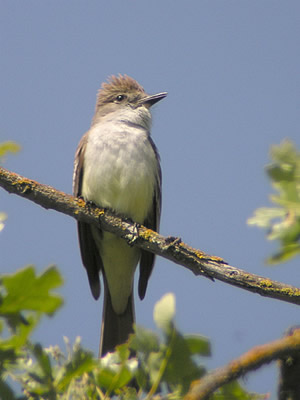
The Ash-throated Flycatcher (Myiarchus cinerascens) arrives in mid-April each year and has been documented to breed fairly widely in the Marin County, preferring natural tree cavities as a nesting site (Shuford, Marin County Breeding Bird Atlas).This bird was photographed at Mt. Burdell on April 27, 2007. (I have a vague feeling that I may have sent this photo before, so forgive any duplication - hope I don't contradict what I said before!).
The Myarchus genus has 11 species, 5 of which are seen in the U.S., but only the Ash-throated is found regularly in California. All in Myiarchus genus are good-sized birds, measuring up to 9 inches. The Ash-throated sports a very pale yellow belly and a perky crest. In the right light you can see rufous on the primaries and the undertail, but not here. Note the broad base of the bill. They hunt from a prominent high perch, so photos often show this sub-optimal perspective.
2. Olive-sided Flycatcher
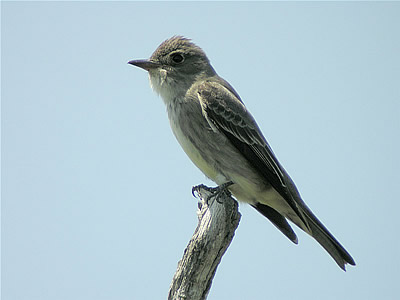
The Olive-sided Flycatcher (Contopus cooperi) is said to have the longest migration route of any flycatcher that breeds in North America. They winter mostly in South America, down as far as Peru, and return to breed in May. Most breed in Canada, but they like moist coniferous forests, so happily for us they breed along the coast in California and up in the Sierras. They are often the flycatcher that takes the highest snag as a hunting perch, from which they fly out up to 50 feet to snatch their preferred prey, a bee or wasp. And we all know the easily recognized song, a pretty whistled "quick THREE BEERS". His tripled "pip" call is also distinctive. This one posed nicely on Blue Ridge Road (near Vacaville), a nice diversion from our search for Black-chinned Sparrow and Lazuli Bunting. Note the streaky "vest" in front of the wing, relatively short tail, and the pale yellow belly. He's not quite finished his lunch yet.
3. Horned Lark
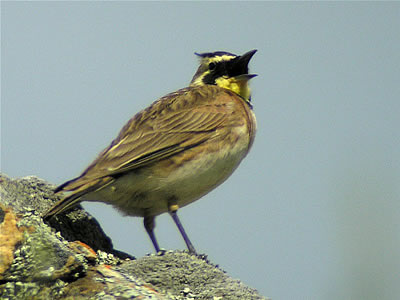
The Horned Lark (Eremophila alpestris) is a widely distributed species, not only across North American, but also in Eurasia ("Holoartic"). They are shy birds that feed on seeds in short grass areas, and are not easily photographed, at least by me. Rather than waiting to send that "perfect shot", I thought you might enjoy this less than sharp photo of a male Horned Lark singing along the trail up from Big Rock, along Lucas Valley Road. Taken May 1, just before the Marin Open Space group began their walk with David Herlocker to this lovely area. Here this male shows the distinctive "horns",l which are not always raised, and the striking yellow and black facial markings. They also sing while flying. At least 15 subspecies are described, and some have white rather than yellow on the face. I know, the rock and lichen are in pretty good focus, but they don't move during the photo.
4. A fledgling to ponder
We just returned from a marvelous Marin Audubon trip to Yuba Pass and the Sierra Valley, led in expert and entertaining fashion by Phil and Pat Gordon. The nesting season is well along for many passerines, and one of the delights of birding in June is the chance to see young birds interact with their parents and siblings. This youngster has likely ventured from the nest only in recent days. We viewed it from a bridge overlooking a marsh in the Sierra Valley (off Route 49, north of Lake Tahoe).
A little quiz for you: can you identify it? The last photograph on this page is of one of its parents!
5. Tree Swallow
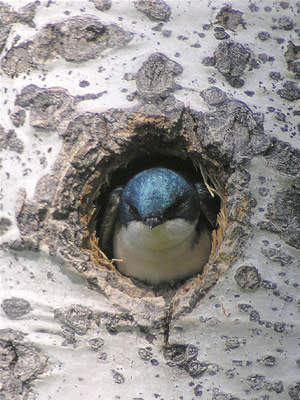
We often see the Tree Swallow (Tachycineta bicolor) in little wooden bird houses, which they seem almost to prefer to natural cavities. Turns out that the size of the hole opening in the standard "bluebird box", which have been erected by the scores of thousands across the country, is quite suitable for our beautiful Tree Swallow, thank-you-very-much. The Violet-green Swallow will also use them happily. See Kenn Kaufman's nice article on this and other "Accidental Good Deeds" that we have performed for our feathered friends, in the July-Aug 2007 issue of Bird Watcher's Digest. (Thanks, Carol F.!)
The electric blue beauty seen here in an alder tree was actively coming and going to his nest, right at the main intersection of the Yuba Pass road. Our group watched from a distance, as the he often posed in the opening before taking off in another sally across the meadow. Tachycineta means "swift mover". And of course it is the "tree" swallow because of its choice in nesting in tree cavities. "Swallow" comes simple from an old Anglo-Saxon word for this type of bird (see Holloway).
6. Black-backed Woodpecker Chick
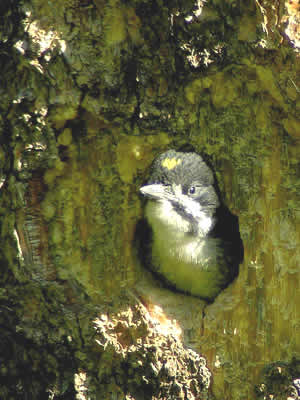
Yuba Pass is a woodpecker magnet. There is a campground among the trees, and in short order we were thrilled to see Red-breasted Sapsucker, White-Headed Woodpecker, Black-backed Woodpecker, and Williamson's Sapsucker, all within a 100 yard radius. Amazing!
Easiest to find was the Black-backer Woodpecker (Picoides arcticus), as it was staked out by 2 photographers with huge lens, stationed about 20 feet from the tree. Our group watched from about 75 feet, wary of disturbing the birds. The photographer came over and explained that they were taking care to insure that their presence was not disturbing the nesting activities. I wonder.......
Anyway, this is a rare woodpecker, largely found in Canada and in areas of fire damaged trees. Fortunately for us they range down to the Sierras in California. The chicks show a yellow forehead patch, more prominent in the male chicks, as shown here. The adult male Black-backed has a larger yellow patch. The closely-related Three-toed Woodpecker is similar. (Black-backed also has only 3 toes).
7. New Grouse (of the Blue Grouse genus)
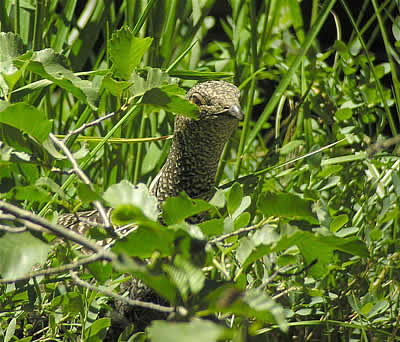
Some years ago while hiking east of Lake Tahoe in June we heard this incredible booming sound. It got louder, and we attempted to walk off-trail to locate the source, which we assumed might be a grouse, which of course everyone knows spend most of their time on the ground. Soon the sound was "all around" us, and impossible to get fix on. We never found the bird, and later found that the male Blue Grouse (Dendragapus obscuras) calls from a high perch, and of course we didn't think to check the trees above our heads!
Then 3 years ago we saw our first Blue Grouse while driving a logging road north of Squaw Valley. Well, the Blue Grouse is no longer a species. In 2006 the AOU split the Blue Grouse into 2 species. We now have the Sooty Grouse (Dendragapus fuliginosus) and the Dusky Grouse (D. obscuras). Since the Sooty Grouse is the Pacific form, I assume it was the Sooty we saw on our Yuba Pass trip last weekend. This hen was carefully watching us as her 2 young chicks foraged in the evergreen understory nearby. This shy species is not easily seen, but when the mom is guarding her chicks she may seek a better vantage point for a lookout, kind of like a sentinel quail.
8. Yellow-headed Blackbird
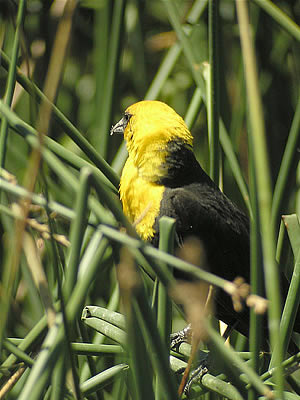
Well, did you manage to identify the mystery fledgling in the little quiz above? This is the adult of the species.
There's no mistaking this creature - that's for sure. The aptly named Yellow-headed Blackbird (Xanthocephalus xanthocephalus) is known to be a fierce defender of his young, and will attack larger birds or even humans that venture too close. The male Yellow-headed rivals the Orioles for top beauty honors in the Icterid family. Perhaps the bill on the youngster (and the habitat of course) helped you with the ID? There appears to be a small insect in dad's bill.
If you enjoyed this little identification challenge, there is another one here.
TOWHEE.NET: Harry Fuller, 820 NW 19th Street, McMinnville, OR 97128
website@towhee.net